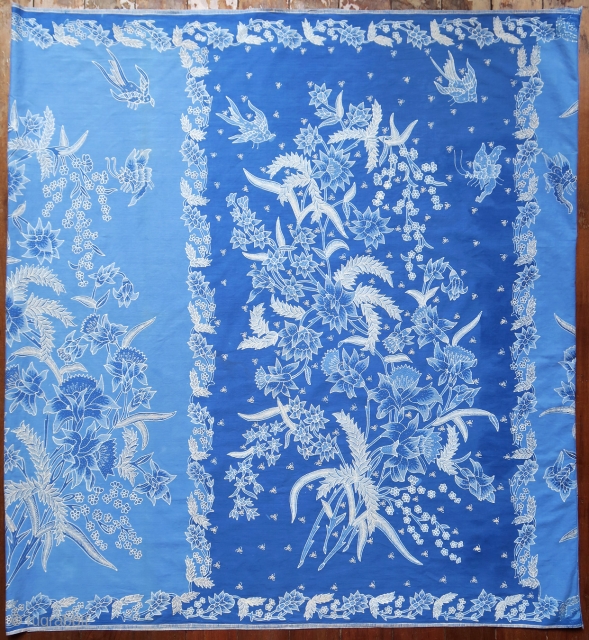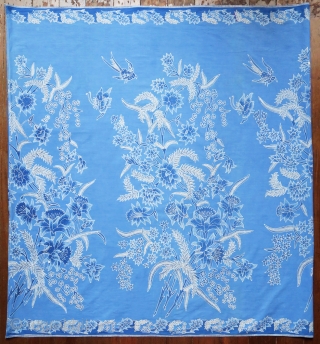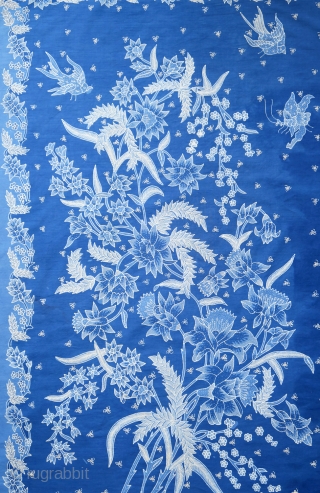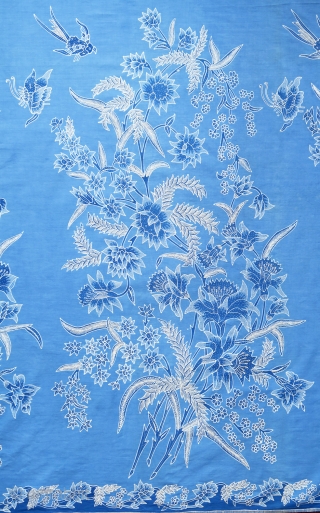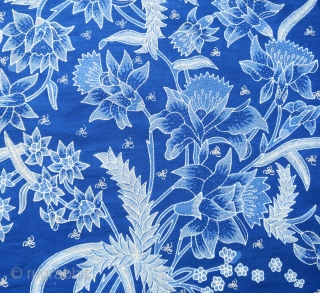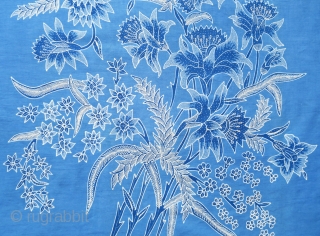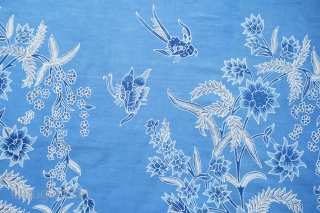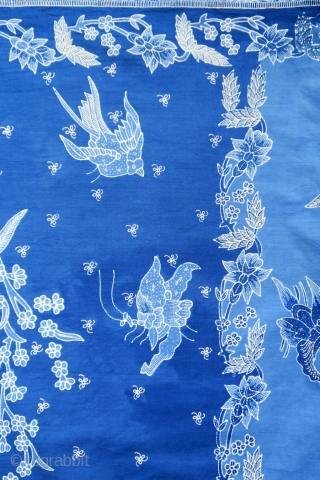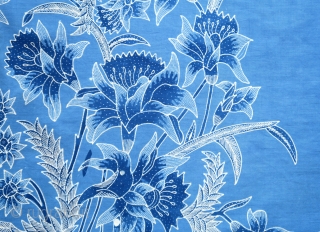Back
Javanese Peranakan Chinese Batik Sarong
Origin: Java, Pekalongan, c. 1950
Technique: Commercial cotton and dyes, hand-drawn (tulis) batik
Description: a Peranakan Chinese sarong hand-drawn with the quintessential Pekalongan design of a detailed flower bouquet. Executed in only two shades of blue, the main body has dark flowers on a light blue body, and the head panel reverses the dark/ light figure/ ground. The flowers are shaded with different densities of white dotted lines to create the impression of many more shades in a 3-dimensional effect for which this style of batik is renowned. Particularly noteworthy is the variation with which the bouquet is repeated four times across the piece, unlike later mechanically repeated renditions of this design. Feathery ferns and curving slender leaves give movement and lightness to the picture, as do the butterfly and bird (both the same size!) hovering above. a flower garland forms borders throughout.
Context: Batik made only in blue and white were a type called kelengan, worn during mourning by Peranakan Chinese, but also traditional in Java and Sumatra.
Condition: The piece is in very good condition, with two very light age lines, and otherwise no stains, holes tears. The blues are vibrant, fresh, and unfaded.
Dimensions: Length: 105 cm. Width: 96 cm (unopened).
Origin: Java, Pekalongan, c. 1950
Technique: Commercial cotton and dyes, hand-drawn (tulis) batik
Description: a Peranakan Chinese sarong hand-drawn with the quintessential Pekalongan design of a detailed flower bouquet. Executed in only two shades of blue, the main body has dark flowers on a light blue body, and the head panel reverses the dark/ light figure/ ground. The flowers are shaded with different densities of white dotted lines to create the impression of many more shades in a 3-dimensional effect for which this style of batik is renowned. Particularly noteworthy is the variation with which the bouquet is repeated four times across the piece, unlike later mechanically repeated renditions of this design. Feathery ferns and curving slender leaves give movement and lightness to the picture, as do the butterfly and bird (both the same size!) hovering above. a flower garland forms borders throughout.
Context: Batik made only in blue and white were a type called kelengan, worn during mourning by Peranakan Chinese, but also traditional in Java and Sumatra.
Condition: The piece is in very good condition, with two very light age lines, and otherwise no stains, holes tears. The blues are vibrant, fresh, and unfaded.
Dimensions: Length: 105 cm. Width: 96 cm (unopened).
price:
On request
- Home
- Antique Rugs by Region
- Category
- Profiles
- Post Items Free
- Albums
- Benaki Museum of Islamic Art
- Budapest: Ottoman Carpets
- Gulbenkian Museum
- Islamic Carpets. Brooklyn
- Islamic Textiles. Brooklyn
- Konya Museum: Rugs
- MKG, Hamburg
- MMA: Caucasian Carpets
- MMA: Mamluk Carpets
- MMA: Mughal Indian Carpets
- MMA: Ottoman Carpets
- MMA: Safavid Persian Carpets
- MMA: Turkmen Rugs
- McCoy Jones Kilims
- Ottoman textiles. Met
- Philadelphia Museum
- Rugs and Carpets: Berlin
- Seljuqs at the Met
- TIEM, Istanbul: Carpets
- V&A: Classical Carpets
- Vakiflar Carpets: Istanbul
- Baluch Rugs: Indianapolis
- Gallery Exhibitions
- Jaf an Exhibition
- Alberto Levi Gallery
- Andean Textile
- Christie's London: 2016
- Francesca Galloway
- HALI at 40
- ICOC Washington, DC 2018
- Jajims of the Shahsavan
- London Islamic Week April, 2018
- Mongolian Felts
- Navajo Rugs: JB Moore
- Persian Piled Weavings
- SF Tribal & Textile Art Show 2020
- SF Tribal 2019
- Sotheby's: C. Alexander
- Turkish Prayer Rugs
- Turkmen Main Carpets ICOC 2007










